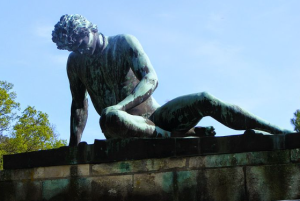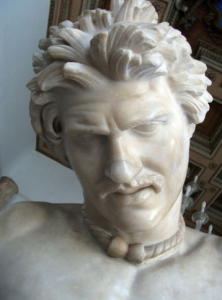The Dying Gaul: History and Major Facts about this Hellenistic bronze sculpture from ancient Greece

History and Facts about The Dying Gaul
The Dying Gaul is a famous Hellenistic bronze sculpture from ancient Greece that dates back to the 3rd century BC. The sculpture depicts a wounded Gallic warrior who is in the process of dying, hence the name “Dying Gaul” or “Dying Galatian”.
Here is are all the important facts about the sculpture:
Who created the sculpture?
The sculpture was originally created by an unknown artist, although it is believed to have been created in Pergamon, an ancient city in present-day Turkey. It is believed that the sculpture was originally part of a larger work of art that commemorated the victories of the Pergamene king Attalus I over the Gauls.
Who does it depict?
The sculpture depicts a Gallic warrior who has been wounded in battle. The warrior is shown naked, except for a torque necklace around his neck, which was a symbol of Gallic nobility. His head is tilted back, and his eyes are closed, as if he is in the process of dying. He is shown slumped over a shield, which is propped up against his left leg. His right arm is extended, as if he is reaching out for help, while his left arm is bent and rests against his side.
A close inspection of the white marble statue also shows that the figure has a bleeding sword puncture in his lower right chest.

The sculpture The Dying Gaul is housed in the Capitoline Museums in Rome, Italy.
Significance of the sculpture
The Dying Gaul is considered to be one of the greatest examples of Hellenistic sculpture. It is highly expressive, with the artist capturing the emotion and pain of the dying warrior in a highly realistic manner. The sculpture is also highly detailed, with intricate details such as the warrior’s wounds, his muscular physique, and the textures of his hair and beard.
The Dying Gaul has been admired for its beauty and emotional power for centuries, and it continues to be an important symbol of the art and culture of ancient Greece. It is also a testament to the impact of the Gauls on ancient Mediterranean history, and their role in shaping the art and culture of the ancient world.
For many centuries, artists all across Europe and beyond have copied the marble statue. At one point, the third U.S. President Thomas Jefferson had wanted to have reproduced statue at Monticello in Virginia.
Some notable copies of The Dying Gaul can be found in Leinster House in Dublin, Ireland, and the Museum of Classical Archeology at Cambridge University. There are also copies all across Europe, including in Stockholm, Prague and Berlin.

The Dying Galatian is considered by many as a very important work from antiquity. It has had a tremendous amount of influence on artists over the centuries. Many of those artists are inspired by the strong emotion the face of the figure oozes. Image: A copy of The Dying Gaul over the gate of the walled garden at Iford Manor, Wiltshire, England.
The sculpture during the Roman era
The sculpture was eventually acquired by the Romans, and it became part of the collection of the Roman Emperor Hadrian. It was then moved to Rome and was displayed in the gardens of the Villa Ludovisi, a luxurious villa owned by the Ludovisi family.
When was the statue re-discovered?
The statue was re-discovered in the early 17th century by archeologists during excavations on the site of the ancient Gardens of Sallust on the Pincian Hill in Rome. A couple of centuries later, other antiquities were discovered on the site where the Dying Gaul was found, including the Ludovisi Throne.
Where can The Dying Gaul sculpture be found?
In the 17th century, the sculpture was acquired by the powerful Borghese family and was displayed in their private collection of the Ludovisi family. Kind courtesy to Pope Clement XII (ruled 1730-1740), the statue became part of the collection of the Capitoline Museums in Rome, where it remains one of the most famous works of ancient art in the world.
Why was the figure depicted naked?

It was initially thought that the figure of the statue was an injured Roman gladiator. Now, we know for fact that the figure is a Galatian warrior. Image: The back of The Dying Gaul sculpture
The Dying Gaul statue was meant to celebrate Pergamon’s victory over the Celtic tribes in Anatolia. It also in a way honors the bravery and tenacity of the Celts, who were known to fight naked.
In one account of Livy about the fighting tactics of the Celts in Asia Minor, the Roman historian appeared to admire the Celts’ bravery since they fought naked. What this meant was that their injuries in battle was there for everyone to see.
However, Greek historian Dionysius of Halicarnassus interpreted this as a reckless and foolish tactic. In keeping up with the Greco-Roman prejudices against the Celts, the Greek historian described their actions on the battlefield as “barbarian boastfulness”.
It’s very much possible that the Celts, like the ancient Greek mythological figures, saw fighting naked as a dignified act that communicated once heroism and fearlessness.
Why did the name change from The Dying Gladiator to The Dying Gaul?
For many centuries, the marble statue was termed as The Dying Gladiator. It was only in the early part of the 20th century that the name changed to The Dying Gaul. It was previously assumed that the sculptor depicted an injured Roman gladiator in the amphitheatre.
Scholars and researchers later found out that the marble was in fact depicting a Gaul or Galatian fighter. This is view is supported by the figure’s thick hair and moustache, and the weapons and carvings on the shield that lie beside him. The Celtic torc that is around his neck is also a major giveaway.

The carnyx depicted near the statue are just some of the tell-tale signs of the sculpture being a depiction of a Galatian warrior and not a Roman gladiator. Image: Carnyx of Tintignac, discovered in Corrèze, France.
A careful analysis of the sculpture will show to the viewer the Gallic carnyx that is placed between his figure’s legs. A carnyx was a type of bronze curved trumpet predominantly used by Celts between the 2nd century BC and the 2nd century AD.
Celt military leaders used the carnyx to rouse up their troops before battle. In some cases, the sound the wind instrument made could be intimidating to opponents. As a matter of fact, the word carnyx comes from the Gaulish root cern- or carn, which means ‘horn’ or ‘antler’.
Other interesting facts

Face of The Dying Gaul statue
The sculpture of The Dying Gaul that we see today (at the Capitoline Museums in Rome, Italy) is believed to be a copy of the original sculpture from the Hellenistic period (323-31 BC). The original is thought to have been sculpted in bronze.
It is believed that the original Dying Gaul sculpture was commissioned somewhere between 235 and 230 BC by Attalus I of Pergamon. He commissioned the artwork to commemorate his victory over the Galatians, a group Celtic tribes that inhabited central Anatolia (i.e. modern-day western and central Turkey).
The third century BC sculptor Epigonus of Pergamon is credited as the person who sculpted the Dying Gaul. Epigonus was a famous artist in the court of the Attalid dynasty in Pergamon.
During the Napoleonic era, The Dying Gaul was taken by Napoleon Bonaparte’s forces [during the invasion of Italy in the late 1790s] from Italy and displayed in the Louvre Museum in Paris, France. It was not until 1816 that the statue made its way back to Rome, Italy.
As a result of the curved trumpet found near the statue, some scholars in the past took to calling the statue “Dying Trumpeter”.
Art lovers in Washington D.C.in the United States had the pleasure of viewing the sculpture at the main rotunda of the National Gallery of Art from December 12, 2013 to March 16, 2014.
























